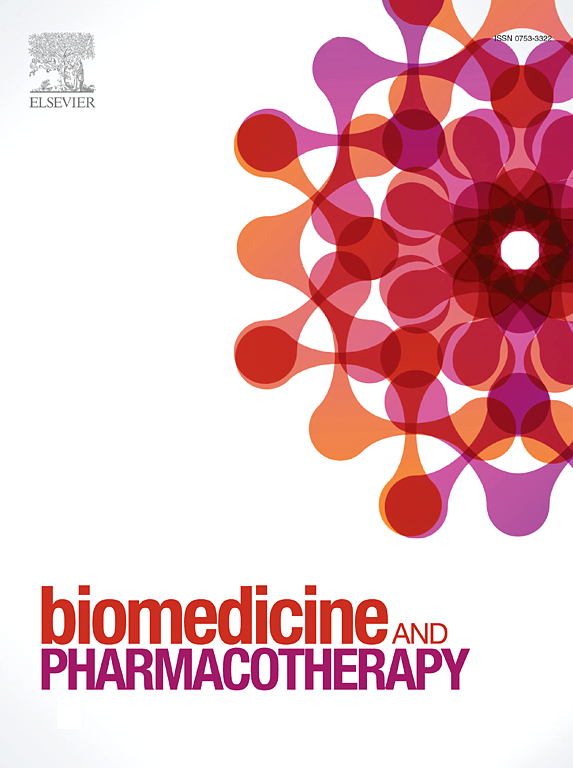尿素A的5 -羟色胺和多巴胺偶联物的合成、表征和抗炎潜能
IF 7.5
2区 医学
Q1 MEDICINE, RESEARCH & EXPERIMENTAL
引用次数: 0
摘要
在了解外源生物与肠道微生物群相互作用方面的进展突出了细菌衍生代谢物作为新型生物活性化合物的有前途的来源。尿素A (UA)是鞣花单宁的后生物代谢物,具有抗炎作用。为了提高UA的生物活性,合成了其与多巴胺(DopUA)或血清素(SerUA)偶联的衍生物(UADs),并对其进行了表征和各种体外生物检测,开发并优化了UADs的合成策略。通过HPLC-DAD-MS/MS和NMR分析证实了化合物的性质和纯度。在永生化骨髓源性巨噬细胞(iBMDMs)中评估UADs的抗炎潜力,分别使用qPCR测量炎症标志物表达,以及FACS分析和Griess测定对细胞因子分泌和亚硝酸盐产生的影响。此外,利用报告细胞系研究NF-κB和Nrf2信号通路的调节。此外,利用秀丽隐杆线虫帕金森病模型进行实验,旨在首次了解UADs在体内的毒性及其对α-突触核蛋白聚集的影响。体外实验表明,与亲本化合物和SerUA相比,在非细胞毒性浓度下,DopUA对亚硝酸盐产生和关键促炎细胞因子分泌的减少作用最为显著。DopUA还能适度抑制NF-κB在报告细胞中的活化。在各自的报告基因检测中,这两种化合物都没有激活Nrf2信号。在秀丽隐杆线虫中,UADs既没有对生存产生不利影响,也没有影响α-突触核蛋白的积累。这些结果表明,神经递质偶联增强了UA的免疫调节作用。该研究促进了利用UA作为有前途的支架来开发靶向促炎途径的治疗方法的想法。本文章由计算机程序翻译,如有差异,请以英文原文为准。
Synthesis, characterization, and anti-inflammatory potential of serotonin- and dopamine-conjugates of urolithin A
Advancements in understanding xenobiotic interactions with gut microbiota highlight bacteria-derived metabolites as a promising source of novel bioactive compounds. Urolithin A (UA), a postbiotic metabolite derived from ellagitannins, has been recognized for its anti-inflammatory properties. To enhance the bioactivity of UA, its derivatives (UADs) conjugated with dopamine (DopUA) or serotonin (SerUA) were synthesized, characterized and subjected to various in vitro bioassays
A synthesis strategy for UADs was developed and optimized. The identity and purity of the compounds were confirmed through HPLC-DAD-MS/MS and NMR analyses. The anti-inflammatory potential of UADs was evaluated in immortalized bone marrow-derived macrophages (iBMDMs) using qPCR to measure inflammatory markers expression, as well as FACS analysis and Griess assay to determine impact on cytokine secretion and nitrite production, respectively. Moreover, reporter cell lines were utilized to investigate the modulation of NF-κB and Nrf2 signaling pathways. Additionally, experiments using Caenorhabditis elegans Parkinson’s disease model aimed to provide first insight into UADs toxicity in vivo and impact on α-synuclein aggregation.
In vitro experiments demonstrated that at non-cytotoxic concentrations, DopUA showed the most potent reduction in nitrite production and secretion of key pro-inflammatory cytokines in comparison with parent compounds and SerUA. DopUA also modestly inhibited NF-κB activation in reporter cells. Neither of the compounds activated Nrf2 signaling in a respective reporter gene assay. In C. elegans, UADs neither impacted survival adversely nor influenced α-synuclein accumulation.
These findings indicate that neurotransmitter conjugation enhances UA's immunomodulatory effects. The study promotes the idea of utilizing UA as promising scaffold for the development of therapeutics targeting pro-inflammatory pathways.
求助全文
通过发布文献求助,成功后即可免费获取论文全文。
去求助
来源期刊
CiteScore
11.90
自引率
2.70%
发文量
1621
审稿时长
48 days
期刊介绍:
Biomedicine & Pharmacotherapy stands as a multidisciplinary journal, presenting a spectrum of original research reports, reviews, and communications in the realms of clinical and basic medicine, as well as pharmacology. The journal spans various fields, including Cancer, Nutriceutics, Neurodegenerative, Cardiac, and Infectious Diseases.

 求助内容:
求助内容: 应助结果提醒方式:
应助结果提醒方式:


